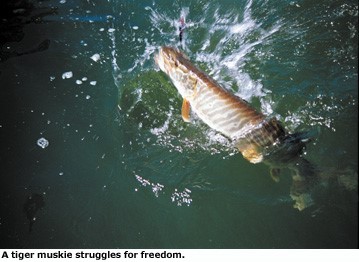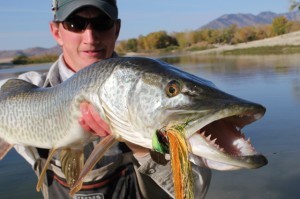Predation Behaviors
As full grown adults, tiger muskies are
apex predators in their environments. This means tiger muskies' food
sources can vary from big game fish like
small mouth and largemouth
bass to small fish like minnows and pan fish. Tiger muskies are even
known to eat birds and small mammals as well as their own juvenile
pare nt species northern pike and muskellunge. A study done by
Wahl and Stein picks
three major food items in a tiger muskies diet: gizzard shad,
fat
head minnows, and blue gill, an analyzed the food item most
preferred, the optimal size of each fish, the bait fish easiest to
live off of, and the reasons why those fish are the easiest prey to
live off.
nt species northern pike and muskellunge. A study done by
Wahl and Stein picks
three major food items in a tiger muskies diet: gizzard shad,
fat
head minnows, and blue gill, an analyzed the food item most
preferred, the optimal size of each fish, the bait fish easiest to
live off of, and the reasons why those fish are the easiest prey to
live off.
For a really interesting but short video on predation behavior of escoids press video
Optimal Prey size depends on how big the
predator is and the prey type. Tiger muskies prefer blue
gill to be 25 to 30 % of their body length, Gizzard shad are
preferred to be between 30 and 36%, and fat head minnows to be 37 to
43% (Wahl and Stein1988). Tiger muskies target bigger gizzard shad
and fathead minnows because they have soft rayed spines; these soft
rayed spines make them much easier victims. In addition to soft
rayed spines, results show that shad and minnows are typically less
reactant to predators and simply less aware of their surroundings
which also make them easy targets. Blue gill on the other hand are
very aware of their surroundings and tend to have a very quick
reaction time when attacked. Blue gill also have hard rayed spines
making it more difficult for predators to eat them without harming
themselves. The defensive mechanisms or lack of defensive mechanisms
directly associate with the bait fish that was captured most often
per strike. In this case gizzard shad were captured 78% of the time
per strike, while minnows were a close second at 67% per strike, and
lastly the hard rayed blue gills dropping the tiger muskies chances
of a capture to 14 % per strike (Wahl and Stein 1988).
In relation
to the statistics above, when tiger muskies are placed in an
environment with only gizzard shad in comparison to an environment
with only blue gill, tiger muskies survive better and grow faster in
the shad environment due to the shads’ lack of defensive mechanisms
and lack of instinctual reactions to predators.
Tiger Musky Behavior with Prey(Wahl and Stein 1988)
Tiger muskies also perform certain behaviors in the presence of prey
depen ding on whether they are aggressive or relaxed at that moment.
ding on whether they are aggressive or relaxed at that moment.
Search: This is when tiger muskies are moving but not orienting
themselves with a prey item.
Follow: Moving and orienting to particular prey
Pursue: Following at a burst of speed
Attack: Striking at Prey
Capture: Grasping prey
Inactive: Resting and motionless not oriented towards prey
Observe: Motionless but oriented to an individual prey, typically
beating their fins
Figure 10. Landed tiger muskie. Photo by Gilbert Rowley.
To continue to the next page press References, to go back to the previous page press Comparison. Finally to go back to our main page press Home.
